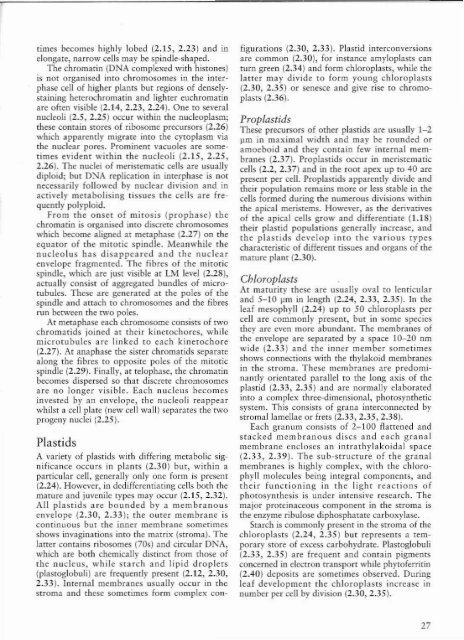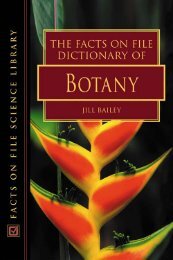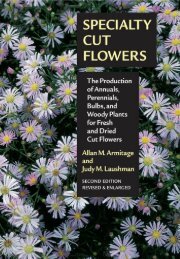You also want an ePaper? Increase the reach of your titles
YUMPU automatically turns print PDFs into web optimized ePapers that Google loves.
times becomes highly lobed (2.15, 2.23) and in<br />
elongate, narrow cells may be spindle-shaped.<br />
The chromatin (DNA complexed with histones)<br />
is not organised into chromosomes in the interphase<br />
cell of higher plants but regions of denselystaining<br />
heterochromatin and lighter euchromatin<br />
arc often visible (2.14, 2.23, 2.24). One to several<br />
nucleoli (2.5, 2.25) occur within the nucleoplasm;<br />
these contain stores of ribosome precursors (2.26)<br />
which apparenrly migrate into the cytoplasm via<br />
the nuclear pores. Prominent vacuoles arc sometimes<br />
evident within the nucleoli (2.15, 2.25,<br />
2.26). The nuclei of meristematic cells are usually<br />
diploid; bU( D:-.JA replication in interphase is nor<br />
necessarily followed b)' nuclear division and in<br />
actively metabolising tissues the cells are frequently<br />
polyploid.<br />
From the Onset of mitosis (prophase) the<br />
chromatin is organised into discrete chromosomes<br />
which become aligned at metaphase (2.27) on the<br />
equator of the mitotic spindle. Meanwhile the<br />
nucleolus has disappeared and the nuclear<br />
envelope fragmented. The fibres of the mitotic<br />
spindle. which are just visible at LM level (2.28).<br />
actually consist of aggregated bundles of microtubules.<br />
These are generated at the poles of tbe<br />
spindle and attach to chromosomes and the fibtes<br />
run between the twO poles.<br />
At metaphase each chromosome consists of n'Vo<br />
chromatids joined at their kinctochores, while<br />
mictotubules arc linked to each kinetochore<br />
(2.27). At anaphase the sister chromatids separate<br />
along the fibres to opposite poles of the mitotic<br />
spindle (2.29). Finally, at telophase, the chromatin<br />
becomes dispersed so that discrete chromosomes<br />
are no longer visible. Each nucleus becomes<br />
invested by an envelope, the nucleoli reappear<br />
whilst a cdl plate (new cell wall) separates the two<br />
progeny nuclei (2.25).<br />
Plastids<br />
A variety of plastids with differing metabolic significance<br />
occurs in plants (2.30) but, within a<br />
particular cell, generally only one form is present<br />
(2.24). However, in dedifferentiating cells both the<br />
mature and juvenile types may occur (2.15,2.32).<br />
All plastids arc bounded by a membranous<br />
envelope (2.30, 2.33); the outer membrane is<br />
continuous bur the inner membrane sometimes<br />
shows invaginarions into the matrix (stroma). The<br />
latter contains ribosomes (70s) and circular DKA,<br />
which are both chemically distinct from those of<br />
the nucleus, while starch and lipid droplets<br />
(plastoglobuli) are frequendy present (2.12, 2.30,<br />
2.33). Imernal membranes usually occur in the<br />
stroma and these sometimes form complex con-<br />
figurations (2.30, 2.33). Plastid interconversions<br />
arc common (2.30), for instance amyloplasts can<br />
turn green (2.34) and form chloroplasts, while the<br />
latter may divide to fotm young chloroplasts<br />
(2.30, 2.35) or senesee and give rise to chromoplasts<br />
(2.36).<br />
Proplastids<br />
These precursors of othet plastids are usually 1-2<br />
]lm in maximal width and may be rounded or<br />
amoeboid and they contain few internal membranes<br />
(2.37). Proplastids occur in meristematic<br />
cells (2.2, 2.37) and in the root apex up ro 40 are<br />
ptesent per cell. Proplastids apparently divide and<br />
their population remains more or less stable in the<br />
cells formed during the numetous divisions within<br />
the apical meristcms. However, as the derivatives<br />
of the apical cells grow and differentiate (1.I8)<br />
their plastid populations generally increase, and<br />
the plastids develop into the various types<br />
characteristic of different tissues and organs of the<br />
mature plant (2.30).<br />
Chloroplasts<br />
At maturity these are usually oval ro lenticular<br />
and 5-10 ]lm in length (2.24, 2.33. 2.35). In the<br />
leaf mesophyll (2.24) up to 50 chloroplasts per<br />
cell are commonly present. but in some species<br />
they arc even marc abundant. The membranes of<br />
the envelope are separated by a space 10-20 nm<br />
wide (2.33) and the inner member sometimes<br />
shows connections with the thylakoid membranes<br />
in the stroma. These membranes are predominantly<br />
orientated parallel to the long axis of the<br />
plastid (2.33, 2.35) and are normally elaborated<br />
into a complex three-dimensional, photosynthetic<br />
system. This consists of grana interconnected by<br />
stromal lamellae or frets (2.33, 2.35, 2.38).<br />
Each granum consists of 2-100 flattened and<br />
stacked membranous discs and each granal<br />
membrane encloses an intrathylakoidal space<br />
(2.33, 2.39). The sub-structure of the granal<br />
membranes is highly complex, with the chlorophyll<br />
molecules being integral components, and<br />
theit functioning in the light reactions of<br />
photosynthesis is under intensive research. The<br />
major proteinaceous component in the stroma is<br />
the enzyme ribulose diphosphatate carboxylase.<br />
Starch is commonly present in the stroma of the<br />
chloroplasts (2.24, 2.35) but represents a temporary<br />
store of excess carbohydrate. Plastoglobuli<br />
(233, 2.35) are frequent and comain pigments<br />
concerned in electron transport while phytoferritin<br />
(2.40) deposits are sometimes observed. During<br />
leaf development the chloroplasts increase III<br />
number per cell by division (2.30, 2.35).<br />
27





